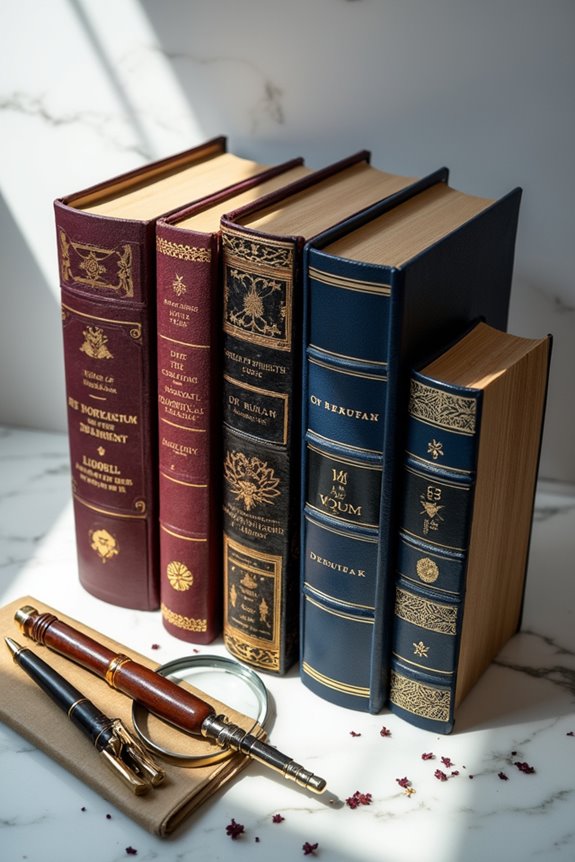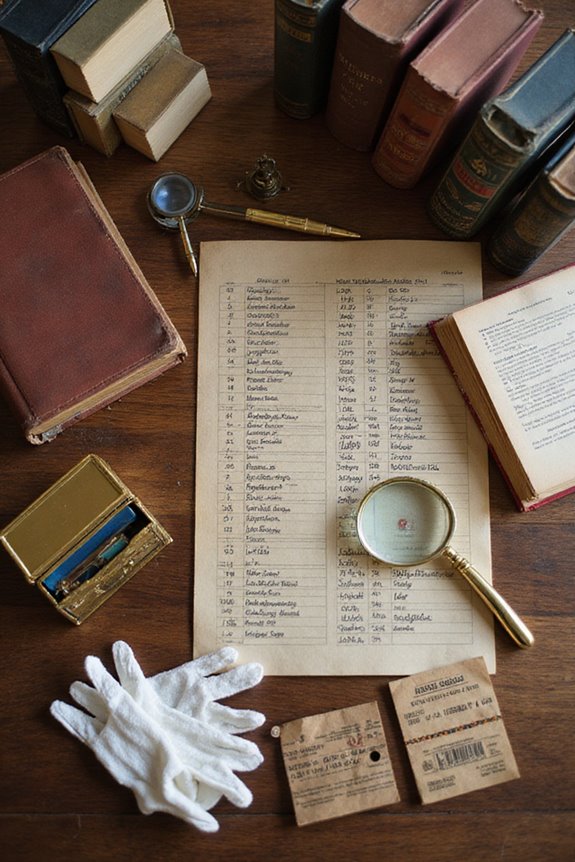When we think about whether hardcover books are better than paperbacks, we should consider a few key points. Hardcovers usually offer better durability, ideal for those treasured reads or textbooks, while paperbacks are lighter and perfect for travel. Though hardcovers come with a higher price tag, their aesthetic appeal and longevity can make them a worthy investment. If you’re building a collection or want something that looks great on your shelf, hardcovers might be the way to go. Stick around, and you’ll discover even more about these formats!
Key Takeaways
- Hardcovers offer superior durability and longevity, making them ideal for heavy use and long-term preservation compared to paperbacks.
- The aesthetic appeal of hardcovers, with their elaborate designs and quality materials, makes them more sought after by collectors.
- Hardcovers often carry a higher perceived value due to publisher prestige and the demand for limited editions.
- While bulkier and less portable, hardcovers provide a more polished look on shelves, enhancing collection strategies.
- Paperbacks are more budget-friendly and convenient for casual reading, attracting price-sensitive consumers.
Price Comparison Between Hardcovers and Paperbacks

When we plunge into the price comparison between hardcovers and paperbacks, it’s easy to get a bit overwhelmed with all the numbers. Generally, hardcover pricing ranges from about $20 to $30, which is typically $10 to $15 more than their paperback counterparts. For instance, trade paperbacks average between $16 and $22, often with some great paperback discounts available. We might find mass-market paperbacks even cheaper, usually under $10! It’s also worth noting that hardcover books often debut first at a premium, and if you’re after a bargain, waiting for the paperback release might be your best bet. So, consider how much you’re willing to spend, and make your choice based on your budget and reading preferences!
Durability: A Closer Look at Book Formats

While it might seem like a small detail, the durability of a book can really influence how enjoyable our reading experience is. When we think about hardcover versus paperback, the binding techniques play an essential role. Hardcovers use sewing or stitching, which boosts their structural integrity compared to paperbacks that rely mainly on glue. This means hardcovers can handle heavy use, making them perfect for textbooks or those special editions we cherish. Plus, that rigid cover protects the pages better, especially when we’re flipping through them often. Remember, while hardcovers might be heavier to lug around, their longevity and resistance to wear can truly enhance how we enjoy our favorite stories over time. Now, isn’t that something to reflect on?
The Impact of Consumer Preference on Sales

Have you ever wondered why some folks gravitate towards hardcovers while others stick to paperbacks? It all comes down to consumer preference and how it shapes sales. Many readers, especially younger ones, are loyal to print, opting for hardcovers for new releases. This preference often drives publishers to prioritize hardcovers, creating a perception of greater value. When hardcovers are launched first, they tap into consumers’ desire for format accessibility—who doesn’t want the latest title right away? Although some paperback sales have declined, they still thrive among price-sensitive readers who wait for reprints. Ultimately, consumer loyalty and smart marketing strategies work together to influence which format dominates the shelves. So next time you buy a book, think about what drives your choice!
Aesthetic Value: Why Hardcovers Attract Collectors

As we explore the world of book collecting, it’s fascinating to see why hardcovers often reign supreme among collectors. Their durability makes them ideal for long-term preservation, ensuring they look great on our shelves for years to come. The artistic appeal of elaborate cover designs and quality binding materials draws us in too. Plus, that luxurious sheen and texture can make even a simple book feel special. In our collector community, the demand for first editions and limited prints adds a layer of excitement, while well-preserved copies can appreciate in value. So, whether you’re considering starting a collection or enhancing your existing one, remember that hardcovers not only look stunning but can be a smart investment, too!
Reader Demographics: Who Prefers What?

What drives our reading format preferences? It often boils down to reader age and income levels. For instance, 68% of younger readers, aged 18 to 29, prefer print books, with 83% of this age group reading last year. But if we look at older readers, particularly those 65 and up, they tend to stick with print as well, despite a growing comfort with technology. Income plays a role too; 86% of those earning over $75,000 read books—a signal they might invest in both hardcovers and paperbacks. On the other hand, lower-income readers often lean towards paperbacks for budget-friendly options. So, knowing your demographic can help us better understand our preferences. Happy reading!
The Role of Production Costs in Pricing
Understanding how production costs influence pricing is key to appreciating the difference between hardcover and paperback books. The production material differences are significant; hardcovers use thicker boards and a more complex binding process, which drives up costs. For instance, while producing 100 hardcovers might cost around $13 each, the same number of paperbacks is closer to $8. Those binding complexity factors add time and expense, with hardcovers typically taking three weeks to produce, compared to one week for paperbacks. So, when we see hardcovers priced higher, it’s not just for the sturdy feel; it’s about those hefty production costs. At the end of the day, knowing this helps us make informed choices about what we buy and enjoy.
Functionality and Portability: Choosing the Right Format
Choosing between hardcover and paperback books can feel like a challenging task, especially when we’re considering functionality and portability. For those of us who are always on the go, paperback advantages shine through. They’re lighter and easier to tote around, perfect for travel or quick commutes. Imagine squeezing a paperback into your bag without breaking your shoulder!
On the flip side, hardcover limitations include their heft and bulk, making them less convenient for casual reading outside our homes. While hardcovers are durable and great for reference, they’re not the best for everyday use. So, if you’re leaning toward comfort and convenience, paperbacks might be your best bet, while hardcovers could be reserved for those treasured reads we want to last.
Genre-Specific Trends in Book Sales
As we think about how to approach our reading choices, it’s interesting to contemplate that not all genres are created equal when it comes to book sales. For instance, hardcover sales in adult fiction soared by 17.8%, thanks to the appeal of deluxe editions. Meanwhile, religious books saw even more impressive growth, with a 23.7% increase in hardcover sales. On the flip side, nonfiction paperback releases are dwindling, showcasing clear genre preferences among readers. These sales dynamics suggest that many of us prefer higher-quality formats. So, whether you’re diving into a gripping novel or exploring spirituality, it might be worth opting for that hardcover—after all, it seems like we’re drawn to them more than ever.
Gift-Giving: The Appeal of Hardcover Books
When it comes to gift-giving, we all want our presents to stand out and be memorable. That’s where hardcover books come in! Their premium gift presentation really elevates the experience. The weight and texture of these books feel luxurious, making them perfect for special occasions. Plus, the durability means they won’t wear and tear like paperbacks do. When we give a hardcover book, we’re not just gifting a story; we’re offering a piece that often holds sentimental value, cherished for years to come. Personalizing it with an inscription can add a special touch! High-quality paper choices enhance the overall gift experience, making it even more impressive. So, the next time you’re on the hunt for that perfect gift, consider a hardcover—it’s a thoughtful choice that can truly make an impact.
Collectibility and Longevity of Hardcover Titles
While many of us might think of books simply as sources of entertainment or knowledge, they can also be valuable collectibles, especially when we consider hardcover titles. These hardcover investments typically have more durable bindings and protective covers, making them better suited for long-term preservation. If you’re delving into the world of collectible editions, keep an eye out for first editions or signed copies, as they often appreciate in value. Books from prestigious publishers like Easton Press can be especially sought after. We’ve all seen paperbacks fall apart quickly, but hardcovers can stand the test of time. So, if you’re looking to build a collection, choosing hardcovers might just be the smartest step!
Frequently Asked Questions
Do Hardcovers Weigh More Than Paperbacks?
When we look at the weight comparison, hardcovers do weigh more than paperbacks. This can lead to portability issues for some of us, making it essential to choose based on our reading habits and preferences.
Can Hardcovers Be Easily Damaged Like Paperbacks?
Like a shield in battle, hardcovers offer spine durability and cover protection. Yet, they aren’t immune to damage. Accidental drops or improper handling can still compromise their integrity, reminding us that no book’s invincible.
Are There Environmental Concerns With Hardcover Production?
Yes, there’re significant environmental concerns with hardcover production. We face sustainability issues and resource consumption challenges, as producing heavy books contributes to deforestation and greenhouse gas emissions, highlighting the need for more eco-friendly practices in publishing.
Which Format Is Better for Note-Taking?
Imagine flipping pages, pen in hand, as we explore our note-taking preferences. For writing durability, hardcovers shine, offering sturdy surfaces and spacious margins. They invite our thoughts to dance freely across the page, unrestrained.
How Do Book Formats Affect Reading Experience?
Book formats greatly influence our reading experience. We value reading comfort and aesthetic appeal, with hardcovers offering a tactile weightiness, while paperbacks enhance portability and casual ease, catering to our diverse preferences as readers.





